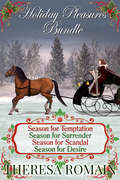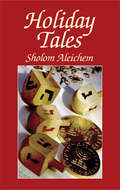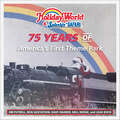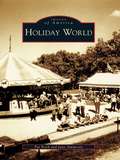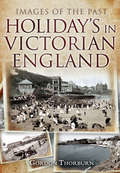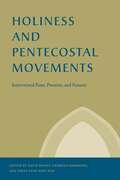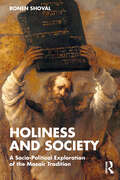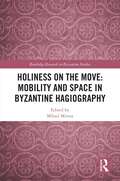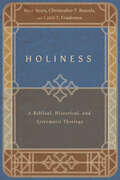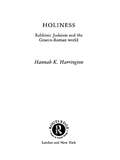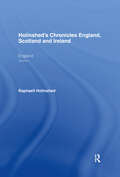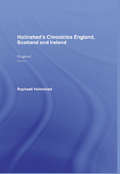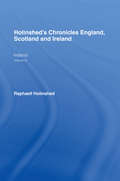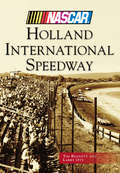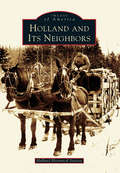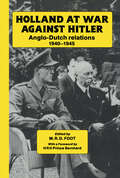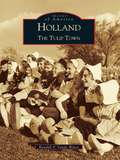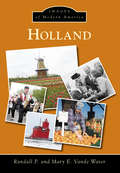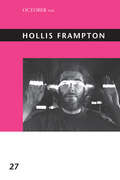- Table View
- List View
Holiday Homecoming & A Soldier for Christmas
by Jillian HartHoliday HomecomingWhen Kristin McKaslin finds herself snowbound for Thanksgiving, Ryan Sanders comes to her rescue. And as their paths cross again and again for each festive occasion, she starts to wonder. She came home for the holidays-would she be willing to stay for love?A Soldier for ChristmasIt's pure chance that has Mitch Dalton walking into Kelly Logan's shop. But when the soldier asks if he can write her, a correspondence courtship starts to thrive. After holiday leave brings Mitch home, he knows he can't leave again without Kelly's promise to be his Christmas bride.
Holiday House Parties: Two Tales
by Elizabeth MansfieldUnlikely lovers find passion under the Christmas mistletoe in this duet of Regency tales from an award-winning romance author. In &“The Girl with Airs,&” Lord Dunvegan—Laird Geordie to his friends—attempts to persuade bluestocking Caroline Woolcott to give his besotted, tongue-tied friend Sir Archibald Halford a chance to win her hand in marriage. A Scotsman banished to England to cultivate a more genteel manner, Geordie has yet to meet a female who tempts him to settle down. It certainly isn&’t the headstrong lass who wants nothing to do with Archie—or Geordie. But then Geordie&’s father decides the standoffish Caroline would make an ideal bride for his wayward son, and a sizzling kiss in the doorway of a grand Lancashire estate turns two warring hearts to love . . . In &“A Sneeze on Tuesday,&” Elinor Selby succumbs to the worst cold she&’s ever known five days before Christmas, and her entire future takes a catastrophic turn. After an absence of five years, Elinor&’s betrothed, Julian Henshaw, Lord Lovebourne, is due home any day. Were it not for her quick-thinking, curmudgeonly neighbor, Miles Endicott, on whom she&’s relied since childhood, she might not be able to cope with the momentous reunion. But then an unexpected series of events forces Elinor and Miles to take part in a scandalous deception that will ignite a firestorm of longing and love. Elizabeth Mansfield&’s pair of irresistible holiday romances features men and women who discover love they didn&’t know they were missing.
Holiday Pleasures (bundled set): Season for Temptation, Season for Surrender, Season for Scandal, Season for Desire
by Theresa Romain“Theresa Romain’s stories [are] full of lovely prose and endearing characters who readers can take to their hearts.”—RT Book ReviewsIn true Regency style, four spirited women find their way to their heart’s deepest desires amidst the glitter and whirl of the Christmas season . . . First there is Julia Herington, impetuous—and irresistible. Brilliant but shy, Louisa Oliver seems destined for spinsterhood until she finds herself the subject of a scandalous bet—and turns it to romantic advantage. And then there is Jane Tindall, a talent for deception her greatest treasure. Her daring taste for gambling draws her into a marriage of convenience that just might lead to love. Lady Audrina Bradleigh is expected to lead fashion and behave with propriety. But as she discovers on the wintry roads of Yorkshire, she is heedless of society’s proper rules when it comes to her heart’s desires. And only one season can twist all their strands of fate into a perfect gift to last a lifetime . . . Praise for Theresa Romain and her Holiday Pleasures “Theresa Romain writes witty, gorgeous, and deeply emotional historical romance.” —Vanessa Kelly, one of Booklist’s “new stars of historical romance” “Theresa Romain has a talent, a rare ability to blend beautiful writing, great characters, delicious banter and a lovely romance, all in one perfect package.” —TBQ’s Book Palace “If you’re looking for a sparkling, witty Regency romance that will have you laughing with joy and sighing with satisfaction, look no further than Theresa Romain’s Season for Temptation.” —The Romance Dish “A holiday charmer that is rife with lively wit, delightful prose, and an abundance of unforgettable characters.” —Library Journal on Season for Surrender “This third book in Theresa Romain's aptly named Holiday Pleasures series is both playful and profound, and has a subtle, stirring power that will affect you long after you've read the final page.” —USA Today’s Happy Ever After blog on Season for Scandal
Holiday Pleasures Bundle
by Theresa RomainIn true Regency style, four spirited women find their way to their heart's deepest desires amidst the glitter and whirl of the Christmas season . . . First there is Julia Herington, impetuous--and irresistible. Brilliant but shy, Louisa Oliver seems destined for spinsterhood until she finds herself the subject of a scandalous bet--and turns it to romantic advantage. And then there is Jane Tindall, a talent for deception her greatest treasure. Her daring taste for gambling draws her into a marriage of convenience that just might lead to love. Lady Audrina Bradleigh is expected to lead fashion and behave with propriety. But as she discovers on the wintry roads of Yorkshire, she is heedless of society's proper rules when it comes to her heart's desires. And only one season can twist all their strands of fate into a perfect gift to last a lifetime . . .
Holiday Tales
by Aliza Shevrin Sholom AleichemSeven childrens' tales, from one of the world's greatest writers of Yiddish stories. Centering around the Jewish holidays, stories include "Benny's Luck," about the amazing good fortune of a young boy and his dreydl, and "Really a Sukkah!" a glimpse of a busy holiday celebration that ends less happily than it began.
Holiday World & Splashin' Safari: 75 Years of America's First Theme Park
by Jim Futrell Dave Hahner Ron Gustafson Nell HedgeAmerica's first theme park, Holiday World & Splashin' Safari, is one of the largest family-owned and -operated independent parks in the United States, and its success is no accident. From moving Interstate 64 closer to the small town to introducing free unlimited soft drinks, four generations of the Koch family have amplified the legacy of this iconic Indiana attraction.Holiday World & Splashin' Safari celebrates the history of the Koch family and Santa Jim Yellig; the origins of Santa Claus, Indiana; and the early years of Santa Claus Land. The story continues with the expansion from Santa Claus Land to Holiday World, the addition of the park's famous trio of top-ranked wooden roller coasters, and the development of Splashin' Safari Water Park, ranked one of the top water parks in the country. For three-quarters of a century, the Koch family has launched the park into worldwide renown and national recognition. Featuring over 100 color illustrations, Holiday World & Splashin' Safari relives this joyous past while looking forward to the thrills fans can expect in the next 75 years.
Holiday World (Images of America)
by Pat Koch Jane AmmesonLouis J. Koch had a dream--one of family, fun, and Christmastime year-round. And so he created Santa Claus Land, the nation's first theme park, in Santa Claus, located in the gentle rolling hills of southern Indiana. Now, six decades later, Koch's legacy lives on at Holiday World and Splashin' Safari. Still owned and operated by the Koch family, Holiday World and Splashin' Safari are consistently voted the friendliest and cleanest parks in the country, and their wooden roller coasters are rated in the top ten list among coaster enthusiasts. The Koch family members treat visitors to the park as family and welcome everyone into what has become a true extension of their home.
Holidays at Home Omnibus
by Grace ThompsonThe beloved saga of a Welsh coastal community coping on the home front through World War II—six novels in one volume! These six heartwarming novels follow the inhabitants of St David&’s Wells, a small Welsh seaside town, charting the highs and lows they experience during the Second World War. From engagements to tragic accidents, the arrival of evacuees to the return of the local soldiers, ice cream indulgences to utter deprivation, this bestselling series from much-loved author Grace Thompson includes: Wait Till SummerSwingboats on the SandWaiting for YesterdayDay TrippersUnwise PromisesStreet Parties
Holidays in Victorian England (Images of the Past)
by Gordon ThorburnIn the country, holidaymakers were a rarity. The railways could take you almost anywhere, but it was only the middle classes who went. So there were no crowds, and many of our pictures show tourist hotspots before they were hot, before there was any such thing as a car park. The text provides local knowledge and background to the photographs and is an enjoyable read in itself, but the real pleasure is in seeing Brighton, Margate, Scarborough, Broadstairs, Clovelly, Ilfracombe, Minehead, before it all happened. See Exmoor, the White Peak, Somerset, when the loudest noise was the click of the camera shutter.
Holidays of the Revolution: Communist Identity in Israel, 1919-1965
by Amir Locker-BiletzkiHolidays of the Revolution explores a little-known chapter in the history of Mandatory Palestine and the State of Israel: the Israeli Communist Party and its youth movement, which posed a radical challenge to Zionism. Amir Locker-Biletzki examines the development of this movement from 1919 to 1965, concentrating on how Communists built a distinctive identity through myth and ritual. He addresses three key themes: identity construction through Jewish holidays (Hanukkah and Passover), through civic holidays (Holocaust Remembrance Day and Israeli Independence Day), and through Soviet and working-class myths and ceremonies (May Day and the October Revolution). He also shows how Jewish Communists viewed, interacted, and celebrated with their Palestinian comrades. Using extensive archival and newspaper sources, Locker-Biletzki argues that Jewish-Israeli Communists created a unique, dissident subculture. Simultaneously negating and absorbing the culture of Socialist-Zionism and Israeli Republicanism—as well as Soviet and left-wing–European traditions—Jewish Communists forged an Israeli identity beyond the bounds of Zionism.
Holiness and Pentecostal Movements: Intertwined Pasts, Presents, and Futures (Studies in the Holiness and Pentecostal Movements #1)
by David Bundy, Geordan Hammond, and David Sang-Ehil HanSince the 1830s, Holiness and Pentecostal movements have had a significant influence on many Christian churches, and they have been a central force in producing what is known today as World Christianity. This book demonstrates the advantages of analyzing them in relation to one another.The Salvation Army, the Church of the Nazarene, the Wesleyan Church, and the Free Methodist Church identify strongly with the Holiness Movement. The Assemblies of God and the Pentecostal Assemblies of the World identify just as strongly with the Pentecostal Movement. Complicating matters, denominations such as the Church of God (Cleveland), the International Holiness Pentecostal Church, and the Church of God in Christ have harmonized Holiness and Pentecostalism. This book, the first in the new series Studies in the Holiness and Pentecostal Movements, examines these complex relationships in a multidisciplinary fashion. Building on previous scholarship, the contributors provide new ways of understanding the relationships, influences, and circulation of ideas among these movements in the United States, the United Kingdom, India, and Southeast and East Asia.In addition to the editors, the contributors are Kimberly Ervin Alexander, Insik Choi, Robert A. Danielson, Chris E. W. Green, Henry H. Knight III, Frank D. Macchia, Luther Oconer, Cheryl J. Sanders, and Daniel Woods.
Holiness and Pentecostal Movements: Intertwined Pasts, Presents, and Futures (Studies in the Holiness and Pentecostal Movements)
by David Bundy, Geordan Hammond, and David Sang-Ehil HanSince the 1830s, Holiness and Pentecostal movements have had a significant influence on many Christian churches, and they have been a central force in producing what is known today as World Christianity. This book demonstrates the advantages of analyzing them in relation to one another.The Salvation Army, the Church of the Nazarene, the Wesleyan Church, and the Free Methodist Church identify strongly with the Holiness Movement. The Assemblies of God and the Pentecostal Assemblies of the World identify just as strongly with the Pentecostal Movement. Complicating matters, denominations such as the Church of God (Cleveland), the International Holiness Pentecostal Church, and the Church of God in Christ have harmonized Holiness and Pentecostalism. This book, the first in the new series Studies in the Holiness and Pentecostal Movements, examines these complex relationships in a multidisciplinary fashion. Building on previous scholarship, the contributors provide new ways of understanding the relationships, influences, and circulation of ideas among these movements in the United States, the United Kingdom, India, and Southeast and East Asia.In addition to the editors, the contributors are Kimberly Ervin Alexander, Insik Choi, Robert A. Danielson, Chris E. W. Green, Henry H. Knight III, Frank D. Macchia, Luther Oconer, Cheryl J. Sanders, and Daniel Woods.
Holiness and Society: A Socio-Political Exploration of the Mosaic Tradition
by Ronen ShovalExploring the subtle political philosophy within the Biblical narrative, this book presents enduring insights that complement Ancient Greek philosophy for contemporary political distinctions – uncovering overlooked socio-political ideologies to provide a unique perspective alongside the classical philosophical tradition.By adopting a sociological approach, Ronen Shovel interprets the Bible as a reflection of perspectives and ideologies, emphasizing the intricate dynamics between rulers and subjects, balancing justice, and power within societies. A key focus is the examination of holiness as a distinct political category, influencing institutions, ethics, justice, and even the use of force. This perspective challenges traditional religious scholarship, merging sociology with the concept of holiness.Holiness and Society enriches political philosophy, religious studies, and sociology, broadening their boundaries and offering fresh perspectives, serving as a bridge between antiquity and modernity, providing valuable insights into contemporary political thought.
Holiness on the Move: Mobility and Space in Byzantine Hagiography (Routledge Research in Byzantine Studies)
by Mihail MitreaHoliness on the Move: Mobility and Space in Byzantine Hagiography explores the literary, religious, and social functions of monastic mobility in Byzantine hagiography, touching on aspects of space, narrative, and identity. The ten chapters included in this volume highlight the multifaceted and rich nature of travel narratives, exploring topics such as authorship and audience, narrative structure and function, identity-making and practicalities of and discourse on travel. In terms of geographical span, the case studies cover Constantinople and its hinterland, Asia Minor, mainland Greece, Trebizond, the Balkans, and southern Italy and range chronologically from the end of the sixth to the fourteenth century. The contributions offer novel insights and perspectives on the importance of mobility in the literary construction of holiness in the Byzantine world and the wider medieval Mediterranean, the spatial dimension of sacred mobility, and the ways in which mobility is employed in the narrative construction of hagiographical texts. As such, the volume joins the burgeoning research on sacred mobilities and will interest students and scholars of Byzantine and medieval literature, religion, and history, as well as a wider readership with an interest in the study of space and mobility.
Holiness: A Biblical, Historical, and Systematic Theology
by Matt Ayars Christopher T. Bounds Caleb T. FriedemanBe holy because I am holy. Be perfect as your heavenly Father is perfect. The Christian life includes many demands, but perhaps none are as challenging or as misunderstood as the biblical command to "be holy" (Leviticus 11:44 and 1 Peter 1:16) or to "be perfect" (Matthew 5:48). How should we understand these charges? In this volume, three scholars from the Wesleyan tradition offer a collective treatment of the theme of holiness that includes: exegesis of key biblical passages a survey across church history theological reflections on the relationship between entire sanctification and other doctrines In addition, the coauthors constructively argue for a "neo-holiness" model that encourages the pursuit of Christian perfection but avoids the pitfalls of Pelagianism by incorporating historic understandings of grace and the work of the Holy Spirit with the best of the Wesleyan tradition. Here, the commands to "be holy" and to "be perfect" take on new meaning. What may have been a burden becomes a blessing.
Holiness: Rabbinic Judaism in the Graeco-Roman World (Religion in the First Christian Centuries)
by Hannah K. HarringtonIn this in-depth exploration of holiness in the context of rabbinic Judaism, Hannah K. Harrington places the rabbinic concept of holiness alongside other notions of the sacred in the Graeco-Roman world. Holistic and yet detailed, this volume provides a much-needed comparative view of this subject during a key period in the development of the Jewish religion.
Holinshed's Chronicles England, Scotland and Ireland
by Raphaell HolinshedFirst Published in 1967. Holinshed's Description of Britain is allowed to contain the most curious and authentic account of the manners and Customs of our Island in the Reign of Henry VIII. and Elizabeth, in which it was written. His History of the transactions of the British Isles, during these periods~, possesses all the force and value of contemporary Evidence, collected by a most skilful Observer; and the peculiar Style and Orthography in which the work is written, furnish a very interesting document to illustrate the history of the English language.
Holinshed's Chronicles England, Scotland and Ireland: Chro.Eng.Scot.Etc 6v
by Raphaell HolinshedFirst published in 1967, Volumes I to VI of a set of Raphell Holinshed’s Chronicles of England, Scotland and Ireland.
Holinshed's Chronicles England, Scotland and Ireland: Ireland Volume VI
by Raphaell HolinshedFirst Published in 1967, this continues the description, conquest, inhabitation and the trouble estate of Ireland according to the chronicles of Holinshed.
Holland International Speedway
by Larry Ott Timothy M. BennettWith its rural farmlands, rolling landscape, locally owned businesses, and tranquil setting, Holland embodies small-town charm. Yet for 54 summers, since 1960, the quiet splendor is interrupted on many Saturday nights by a particular type of roar. It is Holland's racing heritage, known to locals as "Thunder in the Hills." Over the track's long history, many Holland area residents have worked or raced there or enjoyed the racing action as spectators. Holland International Speedway showcases the many cars, stars, officials, and other developments that make up the history of this beloved local track.
Holland and Its Neighbors (Images of America)
by Holland Historical SocietyHolland and Its Neighbors offers a glimpse of bygone times in a rural area of northeastern Vermont along the Canadian border. Holland is typical of many rural small towns. Its neighboring Canadian towns and Norton, Derby, Morgan, and Charleston, Vermont, have familial, geographical, and historical connections that give the area a unique and cohesive culture. Mills and lumber-related businesses were established early, and as land was cleared, farming also became an important way of life. Holland and Its Neighbors includes photographs of loggers and mill workers, while images of horse-drawn equipment and horse-powered machinery illustrate hard work and long hours on hardscrabble farms. Interesting community characters such as Big Jack, peddler Jabez, fortuneteller Marie, hermit Scotty, and Haw Tabor are also pictured.
Holland at War Against Hitler: Anglo-Dutch Relations 1940-1945
by M. R. FootFirst Published in 1990. Routledge is an imprint of Taylor & Francis, an informa company.
Holland: The Tulip Town
by Randall P. Vande WaterOn April 26, 1927, Lida Rogers, a Holland High School biology teacher, suggested an idea to members of the Holland, Michigan Women's Literary Club. The idea was that the city present a "Tulip Day" every spring. Two years later, on May 18, 1929, after scores of visitors viewed more than 100,000 tulips along Holland's curbs, Tulip Time became an annual event.The 1930 Holland Evening Sentinel banner headline read: "Tulip Reigns as Queen of City." Throughout the decade, motion picture and radio personalities visited to promote the festival. The Holland Furnace Company, then the city's largest corporation, sponsored special radio programs that were broadcast nationwide.After World War II, Holland saw the festival grow into the nation's third largest annual event. Visitors have enjoyed parades that included street scrubbing, "klompen" dancing, floats, and more than 50 bands. When Tulip Time began, 85 percent of the names in the Holland telephone directory were Dutch. Over time, the community's cultural diversity has evolved and is now reflected in the festival.
Holland: The Tulip Town (Images of Modern America)
by Randall P. Vande Water Mary E. Vande WaterHolland, Michigan, has a provincial feel while being cosmopolitan, offering the best of both worlds to residents and visitors alike. In 1847, emigrants from the Netherlands founded Holland. For 85 years, the city has remembered its heritage with Tulip Time, a festival that attracts 250,000 visitors each May to view six million tulips. Clinging to tradition, the residents of Holland dress in Dutch costumes to scrub streets and dance in wooden shoes as they are joined by parading bands in the shadow of a 200-year-old windmill. Over the last 50 years, Holland's cultural diversity has evolved along with an outstanding business community in which numerous industries and unique retail outlets flourish. The city is home to Hope College, has won America in Bloom floral honors, contains an award-winning hospital, and features sugar sand beaches.
Hollis Frampton (October Files #26)
by Michael ZrydThe first collection of critical writing on the work of experimental filmmaker Hollis Frampton.Hollis Frampton (1936–1984) was one of the most important experimental filmmakers and theorists of his time, and in his navigation of artistic media and discourses, he anticipated the multimedia boundary blurring of today&’s visual culture. Indeed, his photography continues to be exhibited, and a digital edition of his films was issued by the Criterion Collection. This book offers the first collection of critical writings on Frampton&’s work. It complements On the Camera Arts and Consecutive Matter, published in the MIT Press&’s Writing Art series, which collected Frampton&’s own writings. October was as central to Frampton as he was to it. He was both a frequent contributor—appearing in the first issue in 1976—and a frequent subject of contributions by others. Some of these important and incisive writings on Frampton&’s work are reprinted here. The essays collected in this volume consider Frampton&’s photographic practice, which continued even after he turned to film; survey his film work from the 1960s to the late 1970s; and explore Frampton&’s grounding in poetics and language. Two essays by the late Annette Michelson, one of the twentieth century&’s most influential writers on experimental film, place Frampton in relation to film and art history. ContributorsGeorge Derk, Ken Eisenstein, Hollis Frampton, Peter Gidal, Barry Goldensohn, Brian Henderson, Bruce Jenkins, Annette Michelson, Christopher Phillips, Melissa Ragona, Allen S. Weiss, Federico Windhausen, Lisa Zaher, Michael Zryd


